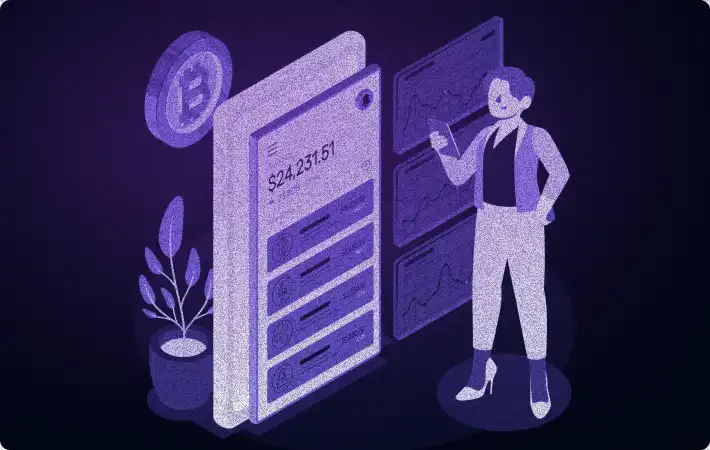How do crypto exchanges make money? A short guide for potential investors
The question "How do exchanges make money?" is frequently asked. Unlike institutional investors and individuals, cryptocurrency exchanges are entities that have managed to stay afloat even during periods of stagnation and decline of the crypto market. This is due to the fact that crypto-exchanges essentially shape the market, stimulate the activity of traders and institutions, and charge money for their services. In this publication we will discuss how much do crypto exchanges make, the main ways of generating profits for crypto exchanges, as well as the subtleties associated with these methods.
Fundamentals
How much do crypto exchanges make? The answer to this question depends on many factors, such as the chosen business model, market conditions, target audience, and so on. To begin with, we want to make a disclaimer that in this publication we will be guided by the classical definition of an exchange. Cryptocurrency trading platforms have brought many innovations and slightly changed the traditional operating patterns, but in any case, exchanges represent and mould market activity, which ultimately determines the price of an asset.
An exchange in the pure form is a closed, self-sufficient system, which works according to the ECN (electronic communication network) principle and has a good level of liquidity. If trade orders are sent to external liquidity providers (like other exchanges) for execution, we are talking about the brokerage model (straight-through processing). Most trading platforms combine these models depending on the current situation, the orders volume, and other factors. The model by which an order is executed can also determine the volume of crypto exchange revenue. This also will be discussed below. Now let’s figure out how Bitcoin exchanges make money and through what methods.
Sources of income for crypto exchanges
So, how do Bitcoin exchanges make money? Simply put, the profits of a cryptocurrency exchange are the difference between the income of the exchange and operating expenses, like maintenance, promotion, liquidity level support, and taxes. In this article, we will try to provide an objective overview of the money-making opportunities offered by the ownership of a crypto exchange, in terms of potential income.
Trading commissions
The main money income of cryptocurrency exchanges results from trading commissions on transactions made by exchange users (traders). Since a trade involves the simultaneous closing of two counter orders (one to sell and the other to buy), then, for instance, with a trading commission of 0.1% of the order value, the exchange will eventually take both a trade commission from the seller's order and a commission from the buyer's order (i. e. 0.1% + 0.1%). However, provided that an order is sent for external execution, the exchange takes a commission only from one side of the transaction.
However, for the exchange to generate trading commissions from transactions and bring profit to its owner, it is necessary to create conditions for active trading, and for this, above all, a sufficient number of active users is required. Of course, there are tools to stimulate trading activity (market makers, trading bots), but it is worth remembering that trading commissions, which bring money to the exchange, can only be generated by real traders.
In this regard, a metric such as the number of active users, or AU, is crucial in evaluating a way of how a crypto-exchange makes money. We should take into account that the domain of cryptocurrency exchanges' financial activity is still very closed, but some fundamental information is available.
So, how much money do crypto exchanges make in this day and age? As an example, let's take the closing of 2021 and the official information on the brightest example, namely the cryptocurrency exchange Binance. According to public data, Binance generated more than $1.8 billion of trading revenues since the start of 2021. With 28.6 million active users, Binance peak trading volume in that year reached $76 billion. Depending on the volume of transactions, commissions varied from 0% to 0.50%.
It is worth comparing these numbers with the period when the crypto market bottomed out in 2018, and only 313,000 users were trading on Binance. Even such activity, which was considered quite low, yielded high revenues for the popular exchanges, and Binance generated $446 million. Of course, compared to the latest data, this figure is not so striking, but it perfectly demonstrates how exchanges can stay afloat even in the most difficult times.
Also, an important issue is an average amount traded by one active user. It is logical to assume that the larger this amount is, the higher the commission received by an exchange. However, the only thing that matters is the volume of transactions by real active users, not the total volume of trading on the exchange, which can be generated by trading bots by 70% or more.
In addition to trading fees, users of trading platforms pay withdrawal fees. The amount of these fees depends on many factors: the asset in which the withdrawal is made, the amount of funds, and the method of transfer. Some trading platforms prefer to charge a fixed withdrawal fee, and some, mostly little-known and emerging crypto exchanges, avoid this fee altogether, thus trying to attract new users. Note that the deposit fee is not recommended even for popular platforms, as it is a strong discouraging factor.
Listings
Large cryptocurrency exchanges can charge from $2 million to $5 million to add a cryptocurrency to their list of tradable cryptocurrencies. At one of TechCrunch conferences, Ethereum's co-founder accused exchanges of charging even higher listing prices, up to $10-15 million. There is no predetermined listing price: each project has an individual money tag, and the set of services that projects need to order to get listed varies from exchange to exchange. It often includes services for the marketing promotion of the token and technical expertise.
For crypto projects, listing on a major marketplace primarily means access to investors and liquidity. After being added to the listings of major crypto exchanges, the prices of such coins usually skyrocket. However, large crypto exchanges either prefer to deny such a money stream or emphasize that even for millions of dollars they are not willing to include low-level coins, also called 'shitcoins,' in their listings.
According to the Blockchain Transparency Institute study, each new project spent, on average, about $50,000 on listing fees in 2018. That's while every month about 100 new coins enter the market. In all, there are several thousand coins listed on exchanges.
IEO, or Initial Exchange Offering
In early 2019, Binance Launchpad reactivated with an offering of BitTorrent tokens, which had not been publicly traded before. The token sale was completed in 18 minutes, selling 59.4 billion BTT tokens and raising about $7.2 million. This method was called Initial Exchange Offering, with an obvious reference to both the traditional exchange term Initial Public Offering and ICOs, which by early 2019 had already completely lost investor confidence.
IEO differs from ICOs primarily because, in the case of IEOs, the partial responsibility for checking the project for obvious connections to fraud falls on the cryptocurrency exchange that will conduct the IEO. The idea is simple: if it's a major crypto exchange with a worldwide reputation, it has no interest in being spotted promoting scams.
The price for an IEO for a project ranges from a couple of tens of thousands of dollars to hundreds or even millions. It all depends on the prominence of the platform that the crypto exchange runs and on which the IEO will take place, and on the set of services that accompanies the token sale. IEO often also includes legal advice, marketing promotion, and technical expertise.
OTC, or Over-the-Counter process
A separate marketplace for institutional investors who place large orders to buy or sell cryptocurrencies is another source of crypto exchange revenue. Crypto exchanges had to split retail investors from institutional ones because large players, placing orders worth millions of dollars, can dramatically affect the course of trading, pushing up or down the price of a cryptocurrency. In addition, OTC trading involves more customized and confidential services. OTC trading is essentially a special platform for such participants who don't want to go public.
OTC trading is in demand both among institutional investors and large asset managers, as well as among miners. The latter category needs platforms to find buyers for big lots of mined cryptocurrency. Usually, there is a minimum order size at OTC marketplaces and it sometimes reaches hundreds of thousands of dollars.
Markups
Markups are a function of advanced software solutions that are responsible for high-quality liquidity and uninterrupted order execution on cryptocurrencies. Markups can be added to all prices that come into the market depth from external suppliers within the brokerage model. This process can be made automated, which is especially useful in the case of arbitrations. Arbitrage situations where bid prices exceed ask prices are highly likely to occur when two or more liquidity suppliers are involved in the aggregation.
The platform operator has two options for dealing with such a situation — either to show arbitrage prices (which is likely to cause customers confusion) or to eliminate them. Markup filters built into the aggregator enable automatic mode to accomplish the latter option. This component adjusts bid or ask prices depending on each specific situation so that the spread is either zero or equal to the specified value. The difference between the original prices and those that got processed by the markup filter can be a source of additional income for a crypto exchange.
Crypto Liquidity Aggregator solution by WL Global include advanced markup filters subsystem to facilitate quote flow processing.
Leverage trading
The availability of a margin trading option on an exchange means that the platform provides the client with trading leverage, which, in fact, is a loan at a certain percentage of the user's trades. Clients can be credited not only with money owned by the exchange, but also with the funds of other clients, which are at the disposal of the trading platform. Also, an exchange can provide traders with funds for leveraged trading, thus implementing the classic brokerage approach. The amount of the remuneration for the provision of borrowed funds is determined in accordance with the established rates.
In case when an exchange decides to connect the brokerage features as well, it can offer its clients an extended set of advanced instruments, like futures and derivatives based on cryptocurrencies. The latter category may be provided with increased leverage, which entails more attractive yields, but also increased losses in case of improper risk management.
The brokerage concept can provide the exchange with opportunities to implement a hybrid business model (A-book/B-book) and make money from all categories of clients, including high-performing ones. However, a caveat should be made here that this is possible only if risk-management procedures are carefully followed.
The main component
So, how do Bitcoin exchanges make money? The main conclusion, which you could probably make on your own, is that the exchange needs active users who generate a stable money income. The more clients your platform has, the higher the volume of trading commissions and more stable the financial situation. You can read about what opportunities exist to attract new users to your crypto exchange, as well as to retain existing users in this article. Remember that even in times of a bear market, you can keep your crypto exchange stable if you calculate the markets correctly and plan for different scenarios.
Contact our consultant if you are interested in discussing advantageous crypto exchange revenue models relevant to your business.



